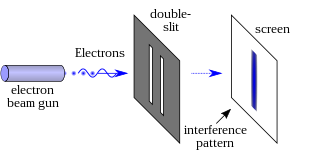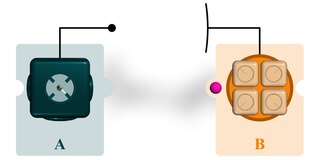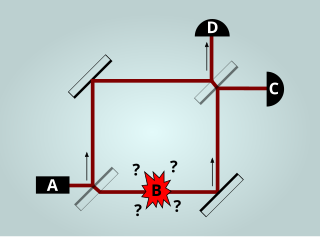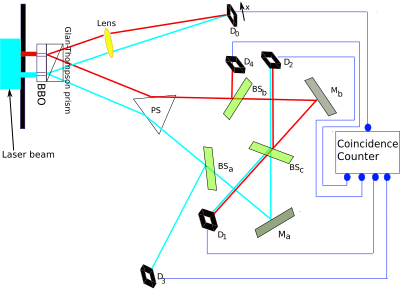
In modern physics, the double-slit experiment demonstrates that light and matter can satisfy the seemingly incongruous classical definitions for both waves and particles. This ambiguity is considered evidence for the fundamentally probabilistic nature of quantum mechanics. This type of experiment was first performed by Thomas Young in 1801, as a demonstration of the wave behavior of visible light. In 1927, Davisson and Germer and, independently George Paget Thomson and his research student Alexander Reid demonstrated that electrons show the same behavior, which was later extended to atoms and molecules. Thomas Young's experiment with light was part of classical physics long before the development of quantum mechanics and the concept of wave–particle duality. He believed it demonstrated that Christiaan Huygens' wave theory of light was correct, and his experiment is sometimes referred to as Young's experiment or Young's slits.
Faster-than-light travel and communication are the conjectural propagation of matter or information faster than the speed of light. The special theory of relativity implies that only particles with zero rest mass may travel at the speed of light, and that nothing may travel faster.

Quantum teleportation is a technique for transferring quantum information from a sender at one location to a receiver some distance away. While teleportation is commonly portrayed in science fiction as a means to transfer physical objects from one location to the next, quantum teleportation only transfers quantum information. The sender does not have to know the particular quantum state being transferred. Moreover, the location of the recipient can be unknown, but to complete the quantum teleportation, classical information needs to be sent from sender to receiver. Because classical information needs to be sent, quantum teleportation cannot occur faster than the speed of light.
Wave–particle duality is the concept in quantum mechanics that quantum entities exhibit particle or wave properties according to the experimental circumstances. It expresses the inability of the classical concepts such as particle or wave to fully describe the behavior of quantum objects. During the 19th and early 20th centuries, light was found to behave as a wave, and then later discovered to have a particulate character, whereas electrons were found to act as particles, and then later discovered to have wavelike aspects. The concept of duality arose to name these contradictions.
The de Broglie–Bohm theory, also known as the pilot wave theory, Bohmian mechanics, Bohm's interpretation, and the causal interpretation, is an interpretation of quantum mechanics. It postulates that in addition to the wavefunction, an actual configuration of particles exists, even when unobserved. The evolution over time of the configuration of all particles is defined by a guiding equation. The evolution of the wave function over time is given by the Schrödinger equation. The theory is named after Louis de Broglie (1892–1987) and David Bohm (1917–1992).
A Bell test, also known as Bell inequality test or Bell experiment, is a real-world physics experiment designed to test the theory of quantum mechanics in relation to Albert Einstein's concept of local realism. Named for John Stewart Bell, the experiments test whether or not the real world satisfies local realism, which requires the presence of some additional local variables to explain the behavior of particles like photons and electrons. As of 2015, all Bell tests have found that the hypothesis of local hidden variables is inconsistent with the way that physical systems behave.

Spontaneous parametric down-conversion is a nonlinear instant optical process that converts one photon of higher energy, into a pair of photons of lower energy, in accordance with the law of conservation of energy and law of conservation of momentum. It is an important process in quantum optics, for the generation of entangled photon pairs, and of single photons.
The Afshar experiment is a variation of the double-slit experiment in quantum mechanics, devised and carried out by Shahriar Afshar in 2004. In the experiment, light generated by a laser passes through two closely spaced pinholes, and is refocused by a lens so that the image of each pinhole falls on a separate single-photon detector. In addition, a grid of thin wires is placed just before the lens on the dark fringes of an interference pattern.

The Elitzur–Vaidman bomb-tester is a quantum mechanics thought experiment that uses interaction-free measurements to verify that a bomb is functional without having to detonate it. It was conceived in 1993 by Avshalom Elitzur and Lev Vaidman. Since their publication, real-world experiments have confirmed that their theoretical method works as predicted.
In quantum mechanics, a quantum eraser experiment is an interferometer experiment that demonstrates several fundamental aspects of quantum mechanics, including quantum entanglement and complementarity. The quantum eraser experiment is a variation of Thomas Young's classic double-slit experiment. It establishes that when action is taken to determine which of 2 slits a photon has passed through, the photon cannot interfere with itself. When a stream of photons is marked in this way, then the interference fringes characteristic of the Young experiment will not be seen. The experiment also creates situations in which a photon that has been "marked" to reveal through which slit it has passed can later be "unmarked." A photon that has been "unmarked" will interfere with itself once again, restoring the fringes characteristic of Young's experiment.

Wheeler's delayed-choice experiment describes a family of thought experiments in quantum physics proposed by John Archibald Wheeler, with the most prominent among them appearing in 1978 and 1984. These experiments are attempts to decide whether light somehow "senses" the experimental apparatus in the double-slit experiment it travels through, adjusting its behavior to fit by assuming an appropriate determinate state, or whether light remains in an indeterminate state, exhibiting both wave-like and particle-like behavior until measured.
The wave–particle duality relation, often loosely referred to as the Englert–Greenberger–Yasin duality relation, or the Englert–Greenberger relation, relates the visibility, , of interference fringes with the definiteness, or distinguishability, , of the photons' paths in quantum optics. As an inequality:
In quantum physics, coincidence counting is used in experiments testing particle non-locality and quantum entanglement. In these experiments two or more particles are created from the same initial packet of energy, inexorably linking/entangling their physical properties. Separate particle detectors measure the quantum states of each particle and send the resulting signal to a coincidence counter. In any experiment studying entanglement, the entangled particles are vastly outnumbered by non-entangled particles which are also detected; patternless noise that drowns out the entangled signal. In a two detector system, a coincidence counter alleviates this problem by only recording detection signals that strike both detectors simultaneously. This ensures that the data represents only entangled particles.
Popper's experiment is an experiment proposed by the philosopher Karl Popper to test aspects of the uncertainty principle in quantum mechanics.
Quantum imaging is a new sub-field of quantum optics that exploits quantum correlations such as quantum entanglement of the electromagnetic field in order to image objects with a resolution or other imaging criteria that is beyond what is possible in classical optics. Examples of quantum imaging are quantum ghost imaging, quantum lithography, imaging with undetected photons, sub-shot-noise imaging, and quantum sensing. Quantum imaging may someday be useful for storing patterns of data in quantum computers and transmitting large amounts of highly secure encrypted information. Quantum mechanics has shown that light has inherent “uncertainties” in its features, manifested as moment-to-moment fluctuations in its properties. Controlling these fluctuations—which represent a sort of “noise”—can improve detection of faint objects, produce better amplified images, and allow workers to more accurately position laser beams.
The Hong–Ou–Mandel effect is a two-photon interference effect in quantum optics that was demonstrated in 1987 by three physicists from the University of Rochester: Chung Ki Hong (홍정기), Zheyu Ou (区泽宇), and Leonard Mandel. The effect occurs when two identical single-photons enter a 1:1 beam splitter, one in each input port. When the temporal overlap of the photons on the beam splitter is perfect, the two photons will always exit the beam splitter together in the same output mode, meaning that there is zero chance that they will exit separately with one photon in each of the two outputs giving a coincidence event. The photons have a 50:50 chance of exiting (together) in either output mode. If they become more distinguishable, the probability of them each going to a different detector will increase. In this way, the interferometer coincidence signal can accurately measure bandwidth, path lengths, and timing. Since this effect relies on the existence of photons and the second quantization it can not be fully explained by classical optics.
Ghost imaging is a technique that produces an image of an object by combining information from two light detectors: a conventional, multi-pixel detector that does not view the object, and a single-pixel (bucket) detector that does view the object. Two techniques have been demonstrated. A quantum method uses a source of pairs of entangled photons, each pair shared between the two detectors, while a classical method uses a pair of correlated coherent beams without exploiting entanglement. Both approaches may be understood within the framework of a single theory.
In physics, the observer effect is the disturbance of an observed system by the act of observation. This is often the result of utilizing instruments that, by necessity, alter the state of what they measure in some manner. A common example is checking the pressure in an automobile tire, which causes some of the air to escape, thereby changing the pressure to observe it. Similarly, seeing non-luminous objects requires light hitting the object to cause it to reflect that light. While the effects of observation are often negligible, the object still experiences a change. This effect can be found in many domains of physics, but can usually be reduced to insignificance by using different instruments or observation techniques.
Hardy's paradox is a thought experiment in quantum mechanics devised by Lucien Hardy in 1992–1993 in which a particle and its antiparticle may interact without annihilating each other.
Quantum microscopy allows microscopic properties of matter and quantum particles to be measured and imaged. Various types of microscopy use quantum principles. The first microscope to do so was the scanning tunneling microscope, which paved the way for development of the photoionization microscope and the quantum entanglement microscope.










